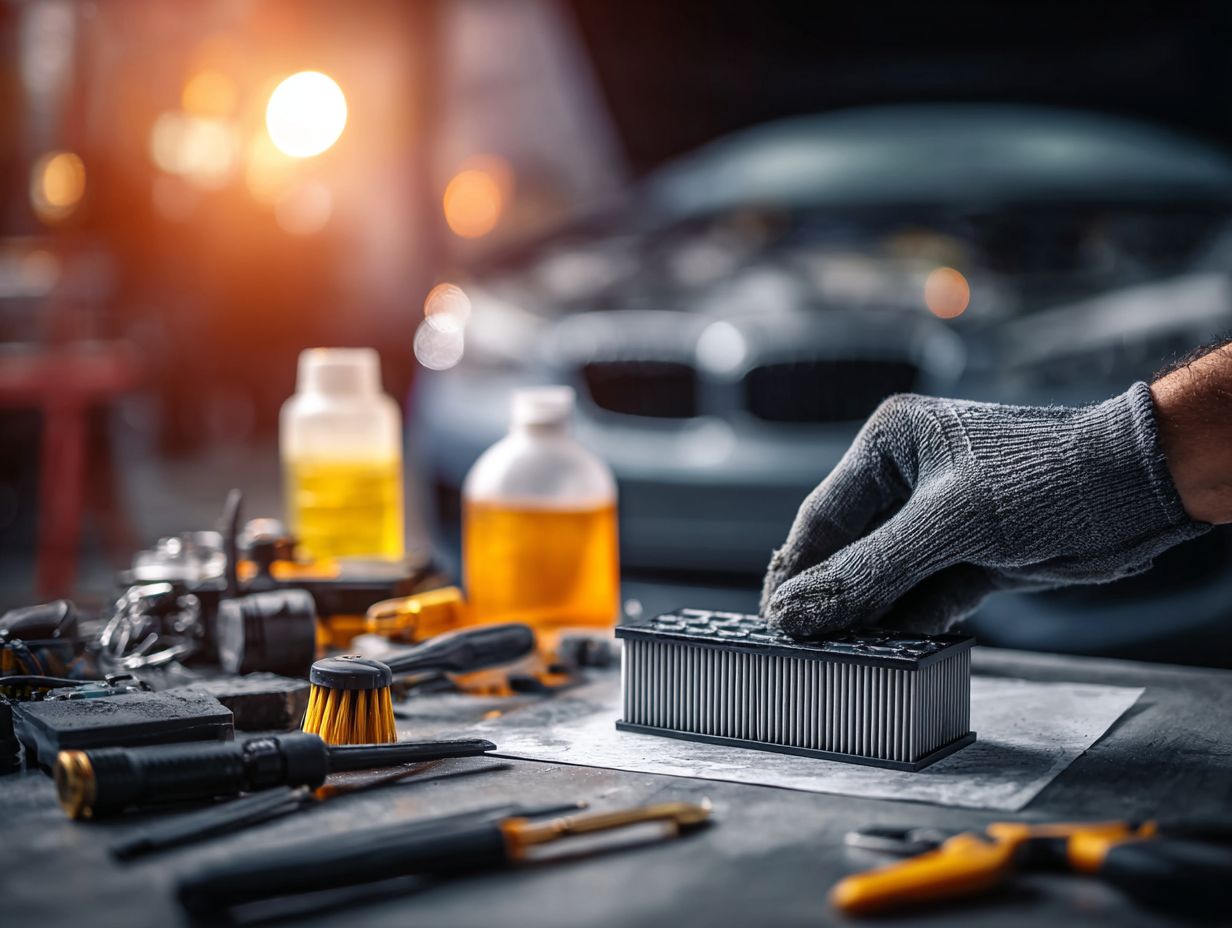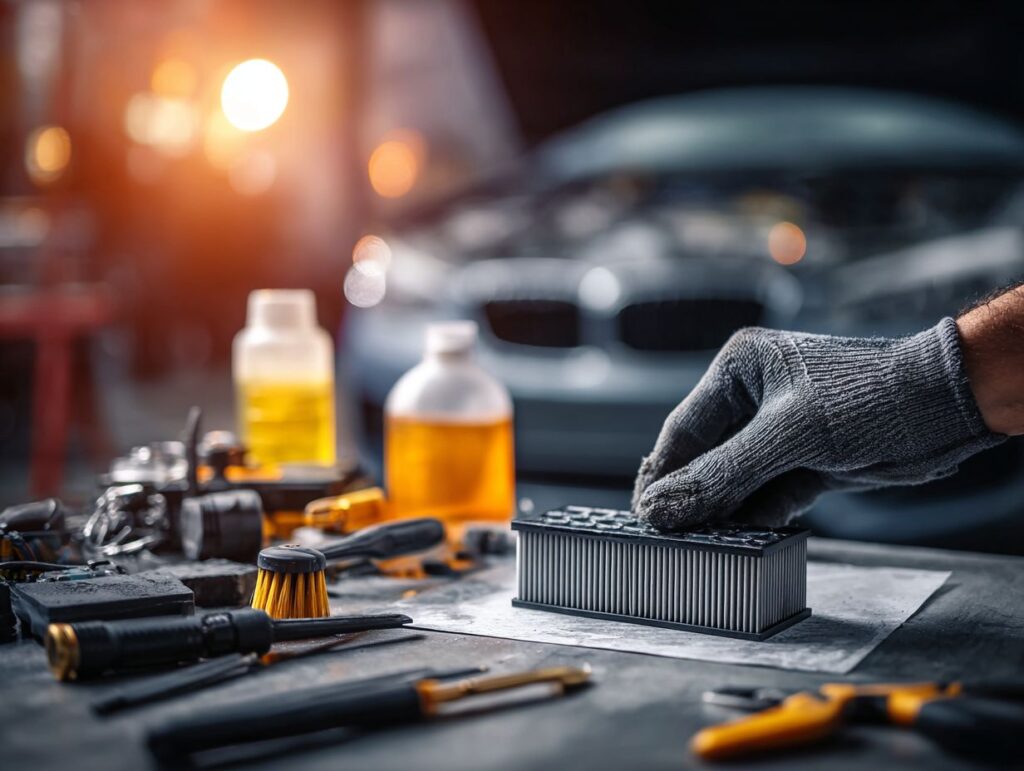Is your car struggling with rough idling or poor fuel economy? A contaminated Mass Air Flow (MAF) sensor can skew air-fuel calculations and cause those exact symptoms. This guide explains how to clean the MAF sensor properly and when to call in the pros at 55 Car Garage in Al Quoz, Dubai—the 90,000 sq. ft., state-of-the-art facility recognized as the biggest car garage in the UAE and the Middle East—for diagnostics or repairs.
Key Takeaways:
- A dirty MAF sensor can affect idle quality, throttle response, and fuel efficiency; cleaning it can restore accurate airflow readings.
- Common clues include rough idle, hesitation, stalling, lower MPG, and a check-engine light (often codes P0101/P0102/P0103).
- Use only dedicated MAF cleaner and gentle technique; avoid contact with the delicate sensing elements.
What Is a MAF Sensor and Why Is It Important?
The MAF sensor measures the amount of air entering the engine so the ECU can meter fuel precisely. Many modern sensors use a heated wire/film whose temperature drop indicates airflow. Accurate readings are critical for smooth performance, emissions control, and fuel economy.
How the MAF Sensor Works
As air flows past the heated element, it cools the element at a rate proportional to airflow. The sensor converts that into a signal the ECU uses to maintain the proper air-fuel ratio. Dirt, oil mist, or dust on the sensing element can insulate it and distort readings—hence the value of careful cleaning.
How to Identify Symptoms of a Dirty MAF Sensor
Early recognition prevents unnecessary part replacements. Watch for rough idle, sluggish acceleration, stalling at stops, and a noticeable drop in MPG. A check-engine light with codes such as P0101, P0102, or P0103 often points to MAF circuit or performance issues.
Common Signs Indicating MAF Sensor Issues
Erratic idle speed, hesitation under load, and difficulty holding a steady speed are classic signs. If these symptoms persist after basic maintenance (like air filter replacement), inspect the MAF for contamination or damage before replacing components.
What Tools Do You Need to Clean a MAF Sensor?
Using the correct products prevents damage to delicate parts.
Essential Cleaning Supplies and Equipment
- Dedicated MAF cleaner spray (e.g., CRC or Liqui Moly), typically AED/USD 10–15.
- Torx or security-Torx drivers (many MAFs use T20/T25), plus a small ratchet if needed.
- Microfiber towels for surrounding components (do not touch the sensing wire with cloths/Q-tips).
- Safety glasses and nitrile gloves.
How to Safely Remove the MAF Sensor
Work gently; the sensor housing and connector pins are easy to damage.
Step-by-Step Removal Process
- Turn the ignition OFF. (Optional: disconnect the negative battery terminal if your manufacturer recommends it.)
- Locate the MAF between the air filter box and the intake tube.
- Unplug the electrical connector by releasing the lock tab—don’t pry on the wires.
- Remove mounting screws with the correct Torx/security-Torx bit.
- Gently withdraw the sensor straight out. Do not touch the hot wire/film.
- Wipe dust from the airbox lip and intake tube around the opening (not the element).
What Is the Proper Cleaning Technique for a MAF Sensor?
1. Using the Right Cleaning Solution
Only use residue-free MAF cleaner. Avoid brake cleaner, carb cleaner, or degreasers—they can leave deposits or attack plastics and coatings.
2. Spray Technique
- Hold the sensor over a clean towel; keep the sensing element facing down so runoff carries debris away.
- From ~10–15 cm away, apply 8–12 short bursts to the sensing wire/film and the internal passage. Do not scrub or use compressed air.
- Allow to air-dry completely (15–30 minutes). Do not speed-dry with heat.
Once fully dry, the sensor can be reinstalled. Starting the engine before the cleaner evaporates can trigger fault codes or damage the element.
How to Reinstall the MAF Sensor Correctly
Correct reinstallation prevents air leaks and repeat faults.
Steps for Proper Reinstallation
- Align the sensor with the airflow arrow pointing toward the engine.
- Install the screws finger-tight, then snug them evenly—no overtightening.
- Reconnect the electrical plug until it clicks. Ensure the intake tube clamps and the air filter box are sealed properly.
- Start the engine and let it idle for a minute. A short test drive should confirm stable idle and throttle response.
What Precautions Should You Take During Cleaning?
Safety Tips to Avoid Damage
- Wear eye protection and gloves; avoid breathing spray mist.
- Never touch the sensing element with tools, cloths, or fingers.
- Keep dirt out of the intake while the sensor is removed; cap the opening if needed.
- Follow your vehicle manufacturer’s service notes; some vehicles may require an idle relearn after battery disconnection.
When Should You Seek Professional Help?

If the check-engine light returns, drivability issues persist, or you find damaged pins, cracked housings, or intake leaks, it’s time for advanced diagnostics. Persistent MAF codes can also stem from vacuum leaks, intake tract leaks, clogged air filters, or wiring faults—not just a dirty sensor.
How Can 55 Car Garage Help with MAF-Related Problems?
At 55 Car Garage—Dubai’s premier auto care destination—our certified technicians use advanced diagnostic procedures to pinpoint the real cause of airflow and mixture issues. From smoke-testing for intake leaks to live-data analysis and ECU adaptation checks, we resolve the root problem, not just the symptom. Visit our engine diagnostics and repair department or explore our comprehensive mechanical services for complete care under one roof.
For routine upkeep that prevents repeat issues, consider our major and minor service packages, and address related ignition items like a spark plug change when due. Ready to get help today? Book an appointment with 55 Car Garage.
What Other Maintenance Tips Improve MAF Performance?
Additional Tips for Optimal Engine Performance
- Replace the engine air filter on schedule; a clogged filter restricts airflow and can contaminate the MAF.
- Inspect intake boots and vacuum hoses for cracks that allow unmetered air.
- Address misfires promptly—excess fuel or oil vapor can foul the sensor.
- Clean the MAF only when symptoms or diagnostics indicate—it’s not a frequent-service item.
How to Monitor Your Car’s Performance After Cleaning
Signs of Improvement and What to Watch For
Post-cleaning, you should notice smoother idle, improved throttle response, and—over a full tank—better fuel economy. Watch for a stable idle RPM and the absence of new fault codes. If available, use an OBD-II app to observe short- and long-term fuel trims; values returning closer to zero typically indicate healthier airflow readings.
Frequently Asked Questions
1. How do I clean my car’s MAF sensor?
Remove the sensor carefully, spray the sensing elements with dedicated MAF cleaner (no touching), let it air-dry completely, and reinstall with correct orientation. Avoid non-residue-free solvents.
2. Why is cleaning the MAF important?
It restores accurate airflow measurement so the ECU can meter fuel correctly—improving drivability, emissions control, and fuel economy.
3. What are the signs my MAF needs attention?
Rough idle, hesitation, stalling, lower MPG, and a check-engine light with airflow-related codes are common indicators.
4. Can I do this without professional help?
Yes, if you follow the correct procedure and use the right cleaner. If symptoms persist, professional diagnostics can uncover intake leaks or wiring faults that mimic MAF issues—our car repair specialists in Dubai can help.
5. Why choose 55 Car Garage for engine diagnostics?
We’re the largest facility in the Middle East with a 90,000 sq. ft. center in Al Quoz, Dubai, equipped with state-of-the-art technology and staffed by certified professionals focused on precision, efficiency, and sustainability—delivering reliable results for luxury and everyday vehicles alike.







